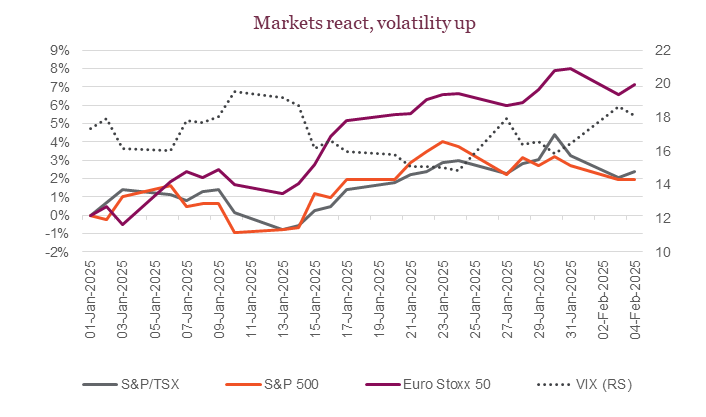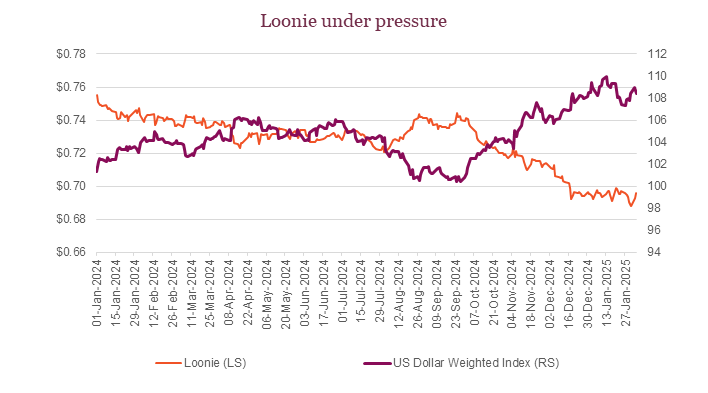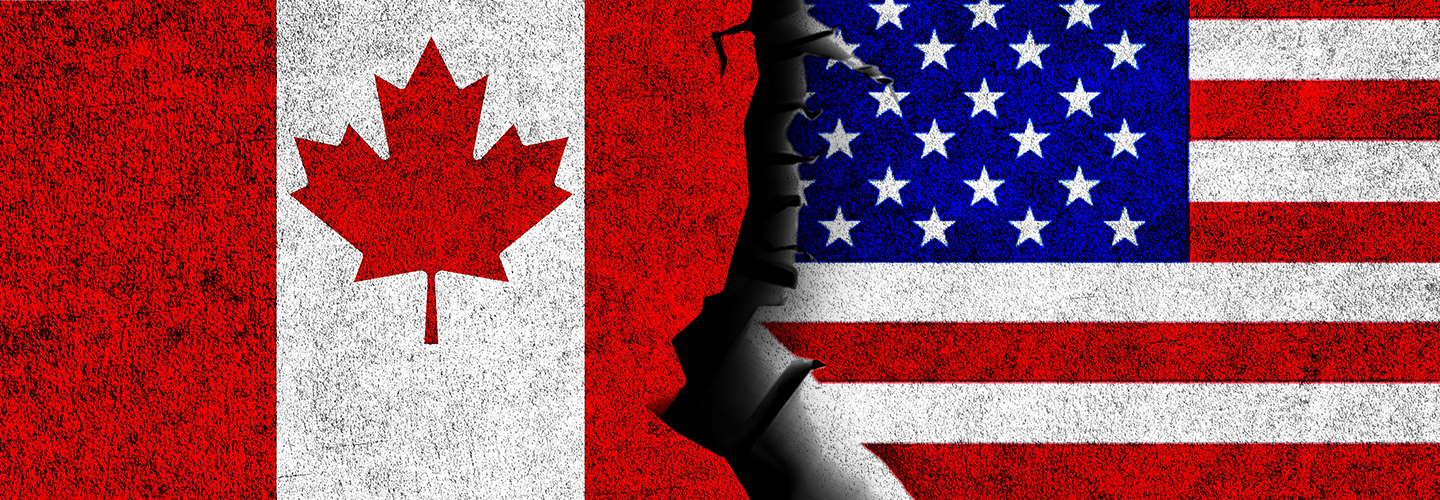Market Insights
February 4, 2025
Is this how you treat your “friends”?
U.S. tariffs and the Canadian response
Despite tariff threats floating around for the last few months, it was still a painful punch to the gut when Trump announced he would follow through on those threats. The punch came from our purported friendly neighbor neighbour, a long-time trade partner and close ally. President Trump set aside his tariffs posturing and went full throttle over the weekend by implementing a 25% tariff on all Canadian imported goods, except for energy products, which will incur a 10% tariff. He similarly applied a 25% tariff on Mexican goods and 10% levy on Chinese imports. While China seems to have been spared for now, keep in mind the 10% tax is on top of existing sanctions put in place during Trump’s first administration and likely won’t be the last tariff act given Trump’s promise to review US-China trade overall.
Trump’s latest tariffs on Canadian and Mexican goods upended a 30-year North American free trade agreement, which first came into effect in 1994 and ironically, later re-negotiated during Trump’s first administration in 2020. Following this weekend’s actions, it’s no longer a question of whether Trump is bluffing, rather, how far is he willing to go to punish countries that he views are taking advantage of the U.S., and what are his ultimate motivation behind tariffs are. We can only make an educated guess, since he’s officially raised border security concerns citing fentanyl trafficking and illegal immigration as reasons to tax Canadian and Mexican goods, yet unofficially he has spoken about using tariffs as a revenue tool while also saying he wants to stop the world from “ripping off” America.
In response to Trump’s unilateral dismantling of the USMCA, Canada initially hit back with its own 25% tariffs on $155 billion worth of goods and vowed to protect Canada’s interests, consumers, workers, and businesses despite Trump’s threats that retaliation efforts would be met with more tariffs. Many provinces also got involved, offering to pull American alcohol from store shelves and cancel contracts with U.S. companies, while vowing to support Canadian brands going forward.

Why all the fuss? The estimates that various think tanks have published on the potential impact of tariffs on global economies all paint a similar picture. These studies suggest the U.S. would take a moderate hit to GDP of about 0.5% with the cushion of a diversified economy to help minimize the impact. Meanwhile Canada, who exports over 75% of its goods to the U.S., would likely incur a larger hit to GDP, potentially paving the way for a recession. While negotiations are ongoing, if the tariffs are to stand, we could see significant supply chain disruptions, and an uptick in inflation, which in the U.S. could upend the Fed’s progress towards taming inflation.
Market reaction
Markets reacted swiftly to the tariff news, with overseas indexes declining in Europe and in Asia (Chinese mainland markets reopen Feb. 5). Initially, major indexes like the S&P 500, Dow, and the S&P/TSX declined, reflecting investor concerns over potential economic impacts. However, following separate discussions between President Trump, Mexican President Claudia Sheinbaum, and Prime Minister Trudeau, the announcement of a one-month reprieve on tariffs, lifted equity indexes from their morning lows, allowing markets to partially recover, particularly in the U.S. with the Dow rebounding to near breakeven. Despite this temporary relief, concerns about a potential global trade war persist.
Overall, the market’s reaction underscores the sensitivity of global financial systems to trade policy changes and the importance of monitoring ongoing developments in international trade relations. The VIX, also known as the market’s fear gauge, rose above 20 early Monday morning, before reverting below 20 by midday. Meanwhile, oil, and not surprisingly the U.S. dollar strengthened, while the Canadian dollar fell to its lowest level since 2003.
What’s next?
Uncertainty abounds. The tariff situation remains fluid and has likely already changed since we last put pen to paper. After announcing tariffs on goods from Canada, Mexico and China over the weekend, Trump has already backtracked and granted Canada and Mexico a one-month reprieve, allowing the two countries time to re-negotiate new trade terms. Even with the one-month extension, we still don’t know the ultimate timing and magnitude of the tariffs, and when it comes to the markets, investors don’t like not knowing. Uncertainty on trade policies can be as damaging to investment decisions as the tariffs themselves –it can lead companies to take a wait-and-see approach, which could translate to less investment, less hiring and weaker corporate earnings.

Monetary policy implications – The U.S. dollar strengthened following the tariffs announcement due in part to the country’s perceived economic resiliency amid a trade war scenario. This means the Federal Reserve may not have to ease interest rates as much as other central banks in response. From Canada’s perspective, should the U.S. administration leave little negotiation room, it is likely the Bank of Canada will have to continue to lower policy interest rates in the face of an already vulnerable economy. Given the potential 3% to 4% hit to GDP the Bank of Canada has estimated in the face of 25% tariffs, it would not be a stretch to see the BoC lower the policy rate substantially, which would help push interest rate differentials further in favor of the dollar.
Other countries – take note. Trump appears fanatical when it comes to tariffs and securing America’s “fair” share on the global trade stage. His recent salvo of tariffs on US’s two largest trading partners may be a first step in what will be become drawn out threats and negotiations across the globe. Trump will likely try to make an example out of Canada and Mexico and will seek concessions that show other countries the seriousness of his threats and the potential means to resolve them. It is unlikely Trump will withdraw tariffs without meaningful U.S. gains, as it would undermine his credibility in future trade negotiations. Even if they are simply political victories, Trump will want to show his base progress on the trade front. The European Union (specifically Germany), and Japan should take notice as they are the next largest trading partners with the U.S., and potentially the next tariff targets.
We’re down, but not out. While there is a lot left up in the air, tensions remain high, and feelings are hurt. Decades of trade progress appear to have disappeared overnight, and the future looks a little more clouded. But even when things look bleak, there are reasons to remain hopeful. Canadians are uniting, vowing to support our own businesses and products, while also partnering with other countries to strengthen ties.
Source: Charts are sourced to Bloomberg L.P., and Richardson Wealth unless otherwise noted.
Authors: An Nguyen, VP Investment Services; Phil Kwon, Head of Portfolio Analytics; Andrew Innis, Analyst
Disclaimers
Richardson Wealth Limited
The opinions expressed in this report are the opinions of the author and readers should not assume they reflect the opinions or recommendations of Richardson Wealth Limited or its affiliates. Assumptions, opinions and estimates constitute the author’s judgment as of the date of this material and are subject to change without notice. We do not warrant the completeness or accuracy of this material, and it should not be relied upon as such. Before acting on any recommendation, you should consider whether it is suitable for your particular circumstances and, if necessary, seek professional advice. Past performance is not indicative of future results. The comments contained herein are general in nature and are not intended to be, nor should be construed to be, legal or tax advice to any particular individual. Accordingly, individuals should consult their own legal or tax advisors for advice with respect to the tax consequences to them.
Forward Looking Statements
Forward-looking statements are based on current expectations, estimates, forecasts and projections based on beliefs and assumptions made by the author. These statements involve risks and uncertainties and are not guarantees of future performance or results and no assurance can be given that these estimates and expectations will prove to have been correct, and actual outcomes and results may differ materially from what is expressed, implied or projected in such forward-looking statements. Assumptions, opinions and estimates constitute the author’s judgment as of the date of this material and are subject to change without notice. Richardson Wealth does not warrant the completeness or accuracy of this material, and it should not be relied upon as such. Before acting on any recommendation, you should consider whether it is suitable for your particular circumstances and, if necessary, seek professional advice. Past performance is not indicative of future results. These estimates and expectations involve risks and uncertainties and are not guarantees of future performance or results and no assurance can be given that these estimates and expectations will prove to have been correct, and actual outcomes and results may differ materially from what is expressed, implied or projected in such forward-looking statements. Unless required by applicable law, it is not undertaken, and specifically disclaimed, that there is any intention or obligation to update or revise the forward-looking statements, whether as a result of new information, future events or otherwise.
Before acting on any recommendation, you should consider whether it is suitable for your particular circumstances and, if necessary, seek professional advice.
The particulars contained herein were obtained from sources which we believe are reliable, but are not guaranteed by us and may be incomplete. This is not an official publication or research report from Richardson Wealth, and is not to be used as a solicitation in any jurisdiction.
This document is for informational purposes only, and is not being delivered to you in the context of an offering of any securities, nor is it a recommendation or solicitation to buy, hold or sell any security.
Richardson Wealth Limited, Member Canadian Investor Protection Fund.
Richardson Wealth is a trademark of James Richardson & Sons, Limited used under license.



